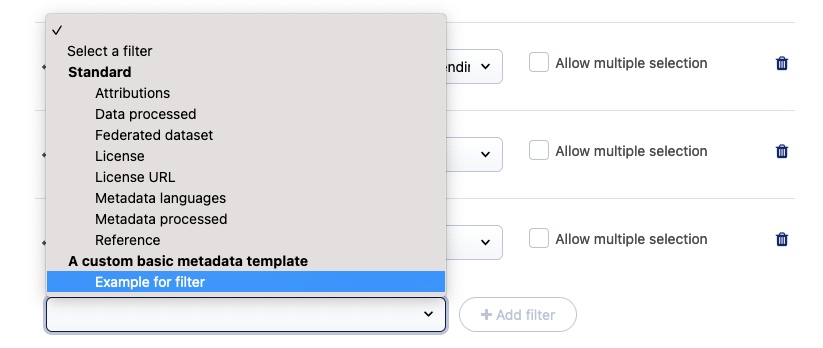 Getting started
Getting started
 Exploring and using data
Exploring and using data
Exploring catalogs and datasets
Exploring a catalog of datasets
What's in a dataset
Filtering data within a dataset
An introduction to the Explore API
An introduction to the Automation API
Introduction to the WFS API
Downloading a dataset
Creating maps and charts
Creating advanced charts with the Charts tool
Overview of the Maps interface
Configure your map
Manage your maps
Reorder and group layers in a map
Creating multi-layer maps
Share your map
Navigating maps made with the Maps interface
Rename and save a map
Creating pages with the Code editor
How to limit who can see your visualizations
Archiving a page
Managing a page's security
Creating a page with the Code editor
Content pages: ideas, tips & resources
How to insert internal links on a page or create a table of contents
Sharing and embedding a content page
How to troubleshoot maps that are not loading correctly
Creating content with Studio
Creating content with Studio
Adding a page
Publishing a page
Editing the page layout
Configuring blocks
Previewing a page
Adding text
Adding a chart
Adding an image block to a Studio page
Adding a choropleth map block in Studio
Adding a points of interest map block in Studio
Adding a key performance indicator (KPI)
Configuring page information
Using filters to enhance your pages
Refining data
Managing page access
How to edit the url of a Studio page
Adding a map block in Studio
Visualizations
Managing saved visualizations
Configuring the calendar visualization
The basics of dataset visualizations
Configuring the images visualization
Configuring the custom view
Configuring the table visualization
Configuring the map visualization
Understanding automatic clustering in maps
Configuring the analyze visualization
 Publishing data
Publishing data
Publishing datasets
Creating a dataset
Creating a dataset from a local file
Creating a dataset with multiple files
Creating a dataset from a remote source (URL, API, FTP)
Creating a dataset using dedicated connectors
Creating a dataset with media files
Federating an Opendatasoft dataset
Publishing a dataset
Publishing data from a CSV file
Publishing data in JSON format
Supported file formats
Promote mobility data thanks to GTFS and other formats
Configuring datasets
Automated removal of records
Configuring dataset export
Checking dataset history
Configuring the tooltip
Dataset actions and statuses
Dataset limits
Defining a dataset schema
How Opendatasoft manages dates
How and where Opendatasoft handles timezones
How to find your workspace's IP address
Keeping data up to date
Processing data
Translating a dataset
How to configure an HTTP connection to the France Travail API
Deciding what license is best for your dataset
Types of source files
OpenStreetMap files
Shapefiles
JSON files
XML files
Spreadsheet files
RDF files
CSV files
MapInfo files
GeoJSON files
KML/KMZ files
GeoPackage
Connectors
Saving and sharing connections
Airtable connector
Amazon S3 connector
ArcGIS connector
Azure Blob storage connector
Database connector
Dataset of datasets (workspace) connector
Eco Counter connector
Feed connector
Google BigQuery connector
Google Drive connector
How to find the Open Agenda API Key and the Open Agenda URL
JCDecaux connector
Netatmo connector
OpenAgenda connector
Realtime connector
Salesforce connector
SharePoint connector
U.S. Census connector
WFS connector
Databricks connector
Harvesters
Harvesting a catalog
ArcGIS harvester
ArcGIS Hub Portals harvester
CKAN harvester
CSW harvester
FTP with meta CSV harvester
Opendatasoft Federation harvester
Quandl harvester
Socrata harvester
data.gouv.fr harvester
data.json harvester
Processors
What is a processor and how to use one
Add a field processor
Compute geo distance processor
Concatenate text processor
Convert degrees processor
Copy a field processor
Correct geo shape processor
Create geo point processor
Decode HTML entities processor
Decode a Google polyline processor
Deduplicate multivalued fields processor
Delete record processor
Expand JSON array processor
Expand multivalued field processor
Expression processor
Extract HTML processor
Extract URLs processor
Extract bit range processor
Extract from JSON processor
Extract text processor
File processor
GeoHash to GeoJSON processor
GeoJoin processor
Geocode with ArcGIS processor
Geocode with BAN processor (France)
Geocode with PDOK processor
Geocode with the Census Bureau processor (United States)
Geomasking processor
Get coordinates from a three-word address processor
IP address to geo Coordinates processor
JSON array to multivalued processor
Join datasets processor
Meta expression processor
Nominatim geocoder processor
Normalize Projection Reference processor
Normalize URL processor
Normalize Unicode values processor
Normalize date processor
Polygon filtering processor
Replace text processor
Replace via regular expression processor
Retrieve Administrative Divisions processor
Set timezone processor
Simplify Geo Shape processor
Skip records processor
Split text processor
Transform boolean columns to multivalued field processor
Transpose columns to rows processor
WKT and WKB to GeoJson processor
what3words processor
Data Collection Form
About the Data Collection Form feature
Data Collection Forms associated with your Opendatasoft workspace
Create and manage your data collection forms
Sharing and moderating your data collection forms
Dataset metadata
Analyzing how your data is used
Getting involved: Sharing, Reusing and Reacting
Discovering & submitting data reuses
Sharing through social networks
Commenting via Disqus
Submitting feedback
Following dataset updates
Sharing and embedding data visualizations
Monitoring usage
An overview of monitoring your workspaces
Analyzing user activity
Analyzing actions
Detail about specific fields in the ods-api-monitoring dataset
How to count a dataset's downloads over a specific period
Analyzing data usage
Analyzing a single dataset with its monitoring dashboard
Analyzing back office activity
Using the data lineage feature
 Managing your users
Managing your users
Managing limits
Managing users
Managing users
Setting quotas for individual users
Managing access requests
Inviting users to the portal
Managing workspaces
 Managing your portal
Managing your portal
Configuring your portal
Configure catalog and dataset pages
Configuring a shared catalog
Sharing, reusing, communicating
Customizing your workspace's URL
Managing legal information
Connect Google Analytics (GA4)
Regional settings
Pictograms reference
Managing tracking
Look & Feel
Branding your portal
Customizing portal themes
How to customize my portal according to the current language
Managing the dataset themes
Configuring data visualizations
Configuring the navigation
Adding IGN basemaps
Adding assets
Plans and quotas
Managing security
Configuring your portal's overall security policies
A dataset's Security tab
Mapping your directory to groups in Opendatasoft (with SSO)
Single sign-on with OpenID Connect
Single sign-on with SAML
Parameters
- Home
- Publishing data
- Dataset metadata
- Creating and editing metadata templates
Creating and editing metadata templates
Updated
by Patrick Smith
Opendatasoft provides a set of default metadata, such as the title, description, themes, keywords, language, license, etc. In most cases these suffice. Other optional templates are also available, for example for interoperability purposes (DCAT, INSPIRE, etc.).
But it's also possible to fill out additional, customized metadata templates to be used in your datasets.
Creating a new basic or admin template

On both the Basic and Admin tabs, you can create a new template by clicking on + Create a template.
Naming the template
The first thing to do is fill out the "Template name" field.
This will automatically fill out the "template identifier," though you can still modify this manually.
Choosing to activate it
If you wish, you can choose to activate the template as soon as it's created. When a template is activated, it is available to be filled out on your datasets' Information tab. You can always activate or deactivate it later if necessary. See below for more information about deactivating templates.
Creating new metadata fields

To create a new metadata field, under "Metadata fields," click on + Add a field.
This opens an interface to guide you through the process.

- First fill out the "Name" of the field.Like for the template itself, the identifier is created automatically, but can be modified if necessary. Note however that once you have created the field, the identifier can no longer be modified.Then click Next.
- From the drop-down menu, specify the type of field you wish to create, then click Next.Note that once you have defined the type, it can no longer be modified.The table below defines the 11 available field types:
Type
Description
Text
This is a single-entry text meant for short entries. If you think you need more space, use the "Long text" field type.
You can define any number of unique values to be suggested. Alternately, auto-complete will suggest values based on those previously entered for this field by other users. (Both options are not available together.)Single-Select
One value can be chosen from a provided list.
Multi-Select
More than one value can be chosen from a provided list.
Free List
Allows users to enter any one value.
You can define any number of unique values to be suggested. Alternately, auto-complete will suggest values based on those previously entered for this field by other users. (Both options are not available together.)Date
Where the contributor will be asked to provide a date.
The date format displayed in your workspace is MM/DD/YYYY, but is available in the API with the format YYYY-MM-DD. Dates are limited to 0 to 9999.
Note that contributors have a Today button they can use to automatically provide the current date.Date & Time
Where the contributor will be asked to provide a date and a time of day.
The date format displayed in your workspace is MM/DD/YYYY 00:00:00, but is available in the API with the format YYYY-MM-DDTHH:MM:SS+00:00, or year-month-day-THour:Minute:Seconds+Timezone. Dates are limited to 0 to 9999.
See this Wikipedia page for help understanding time notation.Note that contributors have a Now button they can use to automatically provide the current date and time.Boolean
This creates a true or false toggle switch. If used in your filters, it will show up under the name you give it, selectable for all datasets for which it's true.
Integer
Accepts numerical values. These can be positive or negative, but must be whole numbers.
Decimal
Like the "Integer" field type, only decimal values are accepted.
Long text with HTML
This field type is meant for longer entries where you want users to have access to HTML.
Long text
This is meant for longer text entries.
Rules: Help text and further options
Help text
This is where you provide a description or information to help users understand the field.
Level of requirement
For every field, once you have defined its type and value, you have the option of making that field optional, recommended, or mandatory.
Catalog filter
This option allows you to add this field to the filters for your catalog and in the Explore API. Having enabled this option for a given field, you can then go to Configuration > Catalog and dataset pages > Catalog page — filters, where that field will now be an option. Select that field and apply it as a filter.

Don't forget to save!
Don't forget to click Save in the upper-right corner once you're done creating of modifying your template.
Modifying an existing template or field
Naturally, if you need to modify a template (or individual field or value) that has not yet begun to be used, there is no issue: Delete the offending template (or field or value) and create its replacement.
It's when a field or value has already begun to be used, however, that there can be unexpected consequences to modifying them.
What happens if I delete a template or a field?
Templates can be deleted by clicking their trashcan icon in the list of templates, or else the three-dot menu to the upper-right inside the template itself.
Modifying fields: a summary view
The table below summarizes what can and cannot be modified within a field. See further down for more information.
Tab | What you can change | What you cannot change |
Information | Name | Identifier |
Type & Values | Values
Text & List
| Once the template has been saved: Field type Values |
Rules | Help text Requirement level Catalog filter setting |
What happens if I delete a value?
If you delete a value from a text or list field (keeping in mind that these values are optional):
- The metadata values themselves will remain as is in the portal and back office. Simply, that option will no longer be proposed for future selections.
If you delete a value from a single-select field (remember, at least one value is required when you create this kind of field):
- In the back office, the previous metadata value will no longer be visible, but will simply be marked "N/A."
- In the portal, the previous metadata value will remain. If the user edits the value and republishes the dataset, the value will be updated.
If you delete a value from a multi-select field (remember, at least one value is required when you create this kind of field):
- The previous metadata value will no longer be visible in the back office. The field will look as if no selection was ever made.
- In the portal, the previous metadata value will remain. If or when the user edits the value and republishes the dataset, at that point the value would be updated.
How about if I just deactivate a template?
- The template remains in your list of templates, marked as inactive.
- In the back office, that template is no longer proposed in your datasets' Information tab.
- In the portal, as well as within the Automation API and Search API, that metadata will not be visible.
However, note that the metadata has not been deleted. Assuming no other change, if you reactivate the template, you will once again be able to see that metadata.
